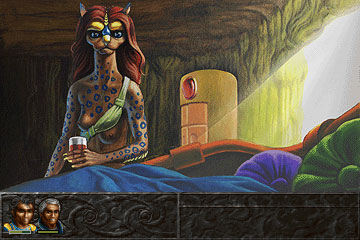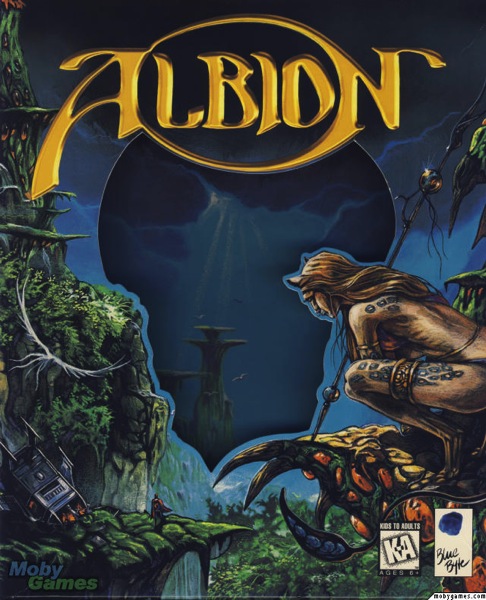On Albion And Avatar
We recently watched the ultra-long cut of James Cameron's Avatar on Blu-Ray, and I was again reminded of a) how much I like the film, and b) what a striking resemblance it bears to Albion, the PC role-playing game I co-wrote in the mid-nineties.
I googled Albion and Avatar and Google suggested "Albion vs Avatar" and "Avatar ripped off Albion", which was kind of cool. The hits were all comments from people who had played Albion, often in articles listing all of the other works Avatar supposedly ripped off. For what it's worth: I don't think Cameron "stole" from Albion at all, although it'd be interesting to know if he ever played it - it's not impossible.
I am going to write about the similarities. Most of my memories of Albion are from 1994-1996, so details may be cloudy or even plain wrong.
Both Albion and Avatar have a big spaceship from Earth, owned by a big corporation and with the purpose of extracting resources from far-off planets. The corporation in Albion was called DDT, which originally stood for Daihatsu-Daimler-Thomson, but which we bastardized a bit to avoid lawsuits (as if). Ironically, both the look of the spaceship interior and the big evil corporation trope were probably partly inspired by Cameron's Aliens. In Albion the spaceship is called Toronto. I have no idea why, although I think I came up with it.
In both Albion and Avatar, rotation is used to simulate gravity. Erik (Simon, co-designer of Albion) argued that if you can create artificial gravity, you can probably do a whole bunch of things that would preclude the kind of world we were building. But we wanted to have the spaceship land on the planet's surface, I think because otherwise we couldn't plausibly stop the threat at the end of the story. (Cameron found a different solution, although one that may turn out to be temporary in the sequel.) So I came up with a structure that could rotate in space and then unfold like a flower (hence "Daisy class") and land on a planet's surface and all the floors would remain floors. It probably wouldn't work at all.
In both Albion and Avatar, even though the expedition is run by a big corporation that is in it for the money, there is a small representation of people with different, nobler goals: scientists. In Albion, every spaceship had to include a governmental scientific team, and of course planets with certain characteristics - say, alien life forms - could not be exploited.
Surprise! The planet in question, while absolutely filled with valuable resources, is not barren at all and inhabited by intelligent aliens. This information is hidden from the scientific team. They fly down on a routine check and then have an 'accident', thus starting the adventure. Avatar's conflict and plot are much, much better than Albion's.
The local aliens are tall, cat-like, have long prehensile tails and use spears. They have bits in their foreheads which they use for magic and which enable them to commune directly with others. So that's quite similar. Unlike in Avatar, the female aliens in Albion have four breasts, and only partially cover them:

Two whole nipples! If you're going to make a game in Europe, you should use any advantage you get. Funnily enough, this was never an issue for the US version, even though typically we'd be asked to make things more aggressive and war-like and remove any hint of sex. Perhaps because at this time Blue Byte was doing its own publishing in the US, although they'd still need to deal with big retailers? I don't know. It's more likely nobody noticed and the game was never that popular.
The US cover (swiped from Mobygames) shows the similarities with Avatar quite nicely:

Alien world, cat-like, tribal alien, spaceship. This image was actually commissioned by Ubisoft for the French release of Albion. I have no idea who made it. Blue Byte then used the image for the US and Korean versions, because it sure beat the German cover which just had the logo on it. And later Ubisoft bought Blue Byte so they now own the rights to the game. Although given that it can be downloaded for free they don't seem to be doing much with it - not that I'd expect them to.
The main storylines of Albion and Avatar are quite different. Avatar has a super-tight plot. Albion is a bit more rambling. I didn't realize this at the time until I started talking about it with Mark Barrett, a friend who is an actual writer. He mentioned Albion's story was more of a picaresque than he expected. That surprised me, but he is right. The protagonist's goal is to get back to the Toronto to warn everyone they're making a huge mistake, so he'd want to travel as directly as possible and not dawdle or explore, and so the story is a pretty linear string of exotic and increasingly difficult - this is an RPG, after all - locales.
There's a big mismatch between the premise of the story and the demands of the genre. Visiting one place after another, rather than deepening the meaning of a few locations, is a weakness in many video game stories. Thinking back on it now, we could have solved this and given the game a more interesting structure and a deeper story. But we probably couldn't have solved the tension between a ticking clock, must-save-the-world premise and a game genre built for exploration. Ironically, this same tension was a big reason why I stopped playing Oblivion, many years later. Our decision to have a fixed protagonist, rather than a player-created one, similarly came from our desire to have "more" story.
The other big, big difference between Albion and Avatar is that on Albion there are humans living on the alien planet. And this ties into what is probably the single biggest source of influence on the game's story: me having read Marion Zimmer Bradley's Mists Of Avalon shortly before work on the game began. (Harriet = Morgaine by the way: small, dark-haired, knows magic. Oh, and the three main characters are called Tom, Dick the AI, and Harriet. Placeholder names that stuck.)
The Celts are on Albion's alien planet because they were being pushed away by encroaching Christianity (like in Mists Of Avalon), and they disappeared into the mists, which I believe corresponds somewhat with Celtic mythology - walls between worlds being thin etc. Only this trip was a deal between two planetary consciousnesses, which is another similarity with Avatar. Only Cameron has a neat scientific explanation for it, whereas we just stated it as fact - it was probably inspired by me reading Giraud and Bati's Altor series.
(Regarding those Celts: I've explained earlier why we named our game Albion. We had a Celtic dictionary and a book on Celtic myth and that was pretty much it in terms of research. In 2008, I befriended a Celtologist in Vienna who was a fan of the game. I once asked him how bad our Celtic influences were, and he politely refused to comment.)
I hope that was vaguely interesting. Albion is available on Abandonia, among other places. You'll need to find a DOS 486 emulator somewhere too.